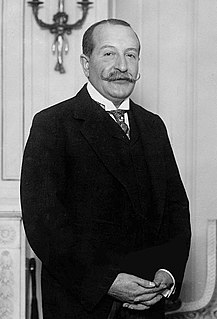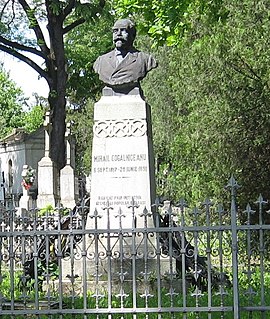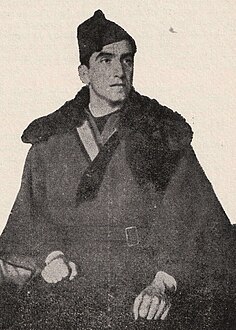
The Ghica family was a noble family active in Wallachia, Moldavia and in the Kingdom of Romania, between the 17th and 19th centuries. The Ghica family produced many voivodes of Wallachia and Moldavia and two Prime Ministers of Romania. Several branches of the family exist today.

Take or Tache Ionescu was a Romanian centrist politician, journalist, lawyer and diplomat, who also enjoyed reputation as a short story author. Starting his political career as a radical member of the National Liberal Party (PNL), he joined the Conservative Party in 1891, and became noted as a social conservative expressing support for several progressive and nationalist tenets. Ionescu is generally viewed as embodying the rise of middle-class politics inside the early 20th century Kingdom of Romania, and, throughout the period, promoted a project of Balkan alliances while calling for measures to incorporate the Romanian-inhabited Austro-Hungarian regions of Transylvania, Banat and Bukovina. Representing his own faction inside the Conservative Party, he clashed with the group's leadership in 1907–1908, and consequently created and led his own Conservative-Democratic Party.

Prince Gheorghe Grigore Cantacuzino, was a Romanian politician and lawyer, one of the leading Conservative Party policymakers. Among his political posts were minister of public instruction in Romania, president of the chamber, and president of the senate. He twice served as the Prime Minister of Romania: between 23 April 1899 and 19 July 1900, and between 4 January 1906 and 24 March 1907. He resigned from office after failing to put down the large-scale peasants' revolt. He was the 20th Romanian politician to serve as PM.

The Cantacuzino or Cantacuzène family is a Romanian aristocratic family of Greek origin, that gave several Princes of Wallachia and Moldavia, claiming descent from a branch of the Byzantine Kantakouzenos family, specifically from the Byzantine Emperor John VI Kantakouzenos. After the Russo-Ottoman War of 1710–11 a lateral branch of the family settled in Russia, receiving the princely status. In 1944 Prince Ștefan Cantacuzino settled in Sweden, where his descendants form part of the unintroduced nobility of the country.
The Conservative Party was between 1880 and 1918 one of Romania's two most important parties, the other one being the Liberal Party. The party was the party of government for a total of 14 years, more than a third of its existence.

Greeks are a historic minority group in Romania. At times, as during the Phanariote era, this presence has amounted to hegemony; at other times, the Greeks have simply been one among the many ethnic minorities in Romania.

The Saint Sava National College, Bucharest, named after the Serbian Saint Sava, is the oldest and one of the most prestigious high schools in Romania. It was founded in 1694, under the name of the Royal Academy of Bucharest.
Gheorghe Cantacuzino may refer to several members of the Cantacuzino family:
Alexandru is the Romanian form of the name Alexander. Common diminutives are Alecu, Alex, and Sandu.

Ioan N. Lahovary or Ion Lahovari; January 25, 1844 – June 14, 1915) was a member of Romanian aristocracy, a politician and diplomat who served as the Minister of Foreign Affairs of Romania.
Alexandru Cantacuzino was a Romanian politician who served as the Minister of Foreign Affairs from June 24, 1862, until September 29, 1862, and as the Minister of Finance from July 12, 1862, until March 16, 1863.

Eternitatea is the biggest cemetery in Iași, Romania.
Alexandru Cantacuzino-Deleanu or Alexandros Kantakouzinos was a Phanariote Romanian-Greek magnate and politician.

Mihail G. Cantacuzino was a Romanian politician. After receiving doctorates in Law and Literature from the University of Paris, he became a prominent member of the Conservative Party. He served as Mayor of Bucharest from 1904 to 1907 and was elected to the Chamber of Deputies for Ialomița County in 1909. He was Justice Minister from December 1910 to January 1914 and again from December 1916 to January 1918 in the national unity government of Ion I. C. Brătianu. In 1922, together with other members of the late Take Ionescu's Conservative-Democratic Party, he joined the Romanian National Party, becoming its vice president for the former Old Kingdom.

Matei B. Cantacuzino was a Romanian jurist and politician.

The first cabinet of Nicolae Crețulescu was the government of Romania from 24 June 1862 to 11 October 1863.

Constantin Brătianu, also known as "Dincă", was a Romanian boyar and politician. He was the father of the Romanian Prime Ministers Dumitru Brătianu and Ion Brătianu.

Prince Alexandru Cantacuzino was a Romanian lawyer and politician, a leading member of the Legionary Movement, and a close collaborator of Legionary leader Corneliu Zelea Codreanu. He notably devised a plot to overthrow Carol II, King of Romania, a plan that would later be taken over by Legionary leader and later Vice President of the Council of Ministers Horia Sima. Cantacuzino was killed on September 22, 1939, at the prison in Râmnicu Sărat, during a retaliation operation ordered by Carol II following the assassination of Prime Minister Armand Călinescu.

Gheorghe Cantacuzino-Grănicerul was a Romanian landowner, general and right-leaning politician who was a member of the Iron Guard, and a member of the Legionary Senate.













